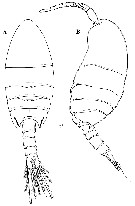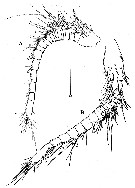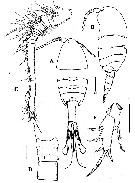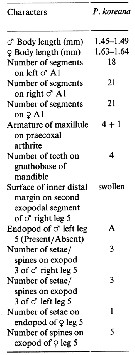|
|
 |
|
Calanoida ( Order ) |
|
|
|
Arietelloidea ( Superfamily ) |
|
|
|
Arietellidae ( Family ) |
|
|
|
Paramisophria ( Genus ) |
|
|
| |
Paramisophria koreana Lim & Min, 2014 (F,M) | |
| | | | | | | Ref.: | | | Lim & Min, 2014 (p.531, Descr. F, M, figs.F, M, Rem.) |  Issued from : B.-J. Lim & G.-S. Min in J. Nat. Hist., 2014, 48 (9-10). [p.533, Fig.6]. Male (from 34°43'N, 128°37'E): A-B, habitus (dorsal and lateral, respectively). Scale bar = 0.25 mm. Nota : Rostrum with a pair of filaments. Cephalosome and 1st pedigerous somite separate, 4th and 5th pedigerous somites fused and bearing dorsolateral processes. Urosome 5-segmented. Caudal rami symmetrical, with 7 setae and setules on outer margin.
|
 Issued from : B.-J. Lim & G.-S. Min in J. Nat. Hist., 2014, 48 (9-10). [p.534, Fig.7]. Male: A, right A1 (posterior view); B, left A1 (posterior view). Scale bar = 0.1 mm. Nota : A1 asymmetrical. Left A1 18-segmented, longer than right. Segment 1 (I-IV) ; segments 2 to 6 (V-VII) ; segment 7 (VIII-X) ; segment 8 (XI) ; segments 9 to 11 (XII-XIV) ; segments 12 to 15 (XV-XVIII) ; segments 16 (XIX) and 17 (XX) ; segment 18 (XXI-XXVIII). Right A1 21-segmented ; segment 1 (ancestral segments I-III) ; segments 2 to 19 (ancestral segments IV-XXI) ; segment 21 (XXIII-XXVIII) with 2 plate-like spiniform processes, 14 +2 aesthetascs.
|
 Issued from : B.-J. Lim & G.-S. Min in J. Nat. Hist., 2014, 48 (9-10). [p.535, Fig.8]. Male: A, A2; B, endopod of A2; C, Md; D, Mx1; E, Mx2; F, Mxp. Scale bars: 0.1 mm (A, C-F); 0.05 mm (B). Nota : A2 : with unarmed coxa. Basis with 1 seta. Endopod elongated, 2-segmented, 1st segment with subdistal seta and fine spinules distally on the surface, 2nd segment with 3 medial and 6 distal setae. Exopod 7-segmented indistinctly, 1st to 3rd segments unarmed, 4th to 6th segments bearing 1, 2 and 1 seta0, respectively, distal segment with 1 medial and 2 terminal setae. Md with 4 teeth plus rounded process between 2nd and 3rd teeth, and 2 rows of spinules on gnathobase. Basis with short setae along outer margin. Endopod reduced, with 2 unequal setae. Exopod 5-segmented, each segment having 1, 1, 1 and 2 setae. Mx1 : praecoxal arthrite with 1 short and 4 long spines. Coxal epipodite with row of 8 outer setae. Basis wiyjout endites and with setae along outer margin. Endopod with 2 unequal setae distally. Exopod ovoid, with 3 distal setae. Mx2 stout. Praecoxa and coxa completely separated ; 1st and 2nd endites of praecoxa with 1 and 2 setae, respectively. Each coxal endite with 2 setae. Basis with 1 stout naked spine on medial margin. Endopod with 4 stout and 4 short pectinate setae. Mxp developed. Praecoxa and coxa fused to form syncoxa, with 1 medial and 2 subdistal setae. Basis and 1stendopod partially fused to form allobasis, with 2 medial and 1 distal setae, and patch of spinules on medial margin. Endopod 5-segmented, each segment having 4, 4, 3, 3, and 4 setae.
|
 Issued from : B.-J. Lim & G.-S. Min in J. Nat. Hist., 2014, 48 (9-10). [p.536, Fig.9]. Male: A-D, P1 to P4 (left legs, posterior views); E, 3rd segment of right P4 (posterior view). Scale bar = 0.1 mm.
|
 Issued from : B.-J. Lim & G.-S. Min in J. Nat. Hist., 2014, 48 (9-10). [p.537, Fig.10]. Male: A, P5 (holotype), posterior view; B-D, 2nd and 3rd segments of right P5 ( paratypes from different localities). Scale bar = 0.1 mm. Nota : P5 asymmetrical. Left leg without endopod ; basis bearing 1 plumose outer seta. Exopod 3-segmented. Right leg uniramous, with basis having 1 simple seta on posterior surface ; exopod 3-segmented indistinctly, and with 2nd and 3rd segments incompletely fused, 1st segment with 1 outer seta, 2nd segment swollen, with 1 seta on outer margin, dense patch of setules covering one small bulge, and soft pointed process subdistally on inner margin, 3rd segment with 3 setae of unequal lengths.
|
 Issued from : B.-J. Lim & G.-S. Min in J. Nat. Hist., 2014, 48 (9-10). [p.538, Fig.11]. Female (paratype): A-B, habitus (dorsal and lateral, respectively); C, right A1 (posterior view; D, genital and 1st abdominal somites (ventral view; arrow indicate copulatory pore); E, left P5. Scale bars: 0.25 mm (A, B); 0.1 mm (C-E). Nota : Rostrum with a pair of filaments. Urosome 4-segmented. Genital double-somite with a pair of ventrolateral gonopores ; single copulatory pore ventrolaterally on right side. Caudal rami symmetrical, with 7 setae and setules on outer margin. Right A1 21-segmented ; P5 symmetrical. Basis and endopod completely fused with 1 seta posterolaterally ; endopod produced into acute process, with 1 plumose seta and rounded process ; exopod 1-segmented with 3 short spines along outer margin, 1 distal, and 1 short subdistal spine ; length of distal spine about 2.5 times as long as thazt of subdistal spine. Exopodal segment produced into acute process distally, positioned between distal spine and subdistal spine.
|
 Issued from : B.-J. Lim & G.-S. Min in J. Nat. Hist., 2014, 48 (9-10). [p.532, Table 3]. Morphological characteristics. Nota: Compare within Paramisophia species of northeastern Asia: See P. itoi, P. platysoma, P. japonica, P. sinica, P. sinjinensis.
| | | | | NZ: | 1 | | |
|
Distribution map of Paramisophria koreana by geographical zones
|
| | | | | | | Loc: | | | China Seas (Korea Strait: Geojedo Is., Geomundo Is., Cheongsando Is., South Korea).
Type locality: 34°43'N, 128°37'E. | | | | N: | 1 | | | | Lg.: | | | (1159) F: 1,63; M: 1,45; 1,49; {F: 1,63; M: 1,45-1,49} | | | | Rem.: | For Lim & Min (2014, p.539) this species resembles P. cluthae and clustered with P. ammophila, P. cluthae, P. variabilis, P. reducta and P. mediterranea in a fourth group (issued from cladograms by the cladistic analysis of Paramisophria species). | | | Last update : 27/01/2015 | |
|
|
 Any use of this site for a publication will be mentioned with the following reference : Any use of this site for a publication will be mentioned with the following reference :
Razouls C., Desreumaux N., Kouwenberg J. and de Bovée F., 2005-2025. - Biodiversity of Marine Planktonic Copepods (morphology, geographical distribution and biological data). Sorbonne University, CNRS. Available at http://copepodes.obs-banyuls.fr/en [Accessed November 28, 2025] © copyright 2005-2025 Sorbonne University, CNRS
|
|
 |
 |










